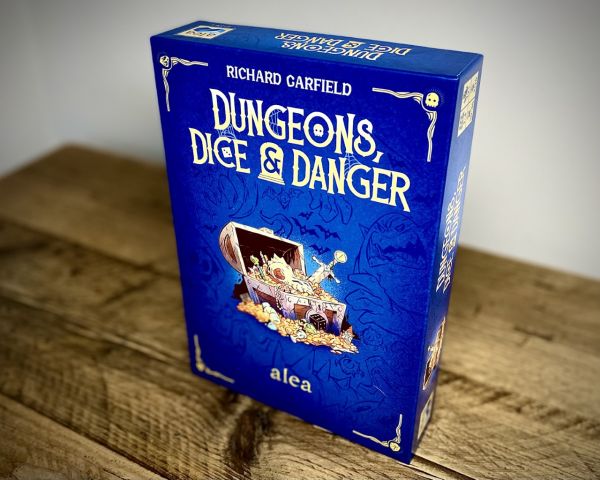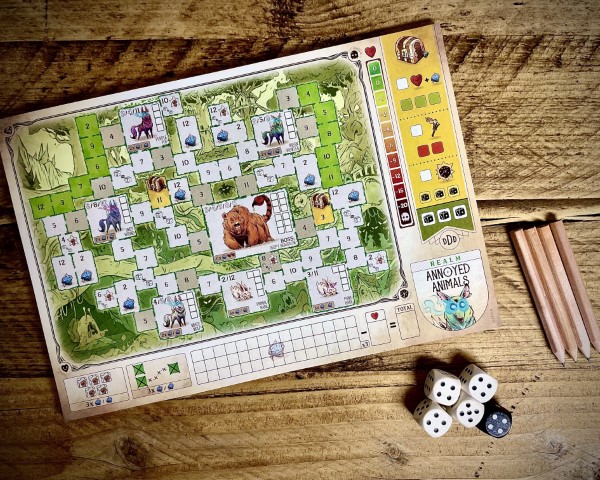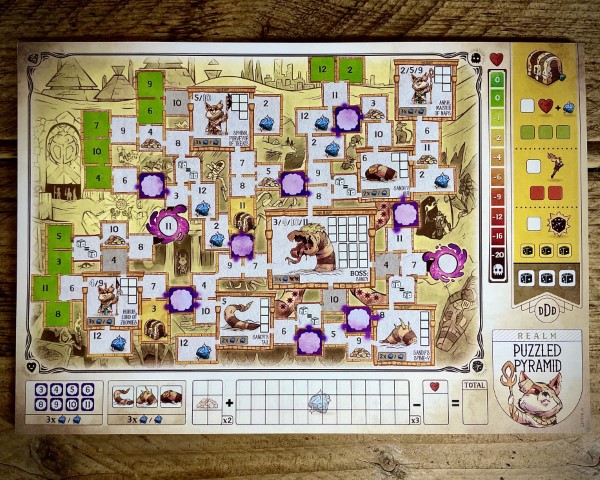Navigate a Labyrinth, Slay Monsters, and Gather Treasure in Dungeons, Dice & Danger

Take the role of a hero and use the best of your abilities to navigate a labyrinth filled with rewards. Fight various beasts and discover valuable treasures in Dungeons, Dice & Danger.
The roll-and-write hype found its way into the fantasy realm of the dungeon-crawling genre. Uncover the depth of a challenging adventure packed neatly into one-page maps, dice, and pencils; no long setups nor heavy-weight rulebooks.
Enjoy a journey into four unique dungeons traveling through spaces you unlock and mark based on your dice rolls. You will face monsters, improve your abilities, unlock unique skills, and collect loot on your path to Victory.
Dungeons, Dice & Danger was designed by Richard Garfield, who created the spectacular Magic: The Gathering, the first Collectible Card Game (CCG). Dungeons, Dice & Danger is produced by Ravensburger, known for top-rated games including Villainous, Castles of Burgundy, Puerto Rico, and Labyrinth, among many others. Hence, this game comes to market with high expectations, and the game delivers.

Gameplay
One map, one pencil per player, and game dice ready to roll. End of setup!
A dungeon map contains numbered spaces and Monster rooms. Spaces include Start (green), Regular (white), Activating (gray), and Special (symbols). Monster rooms display their Life points. The side of the map displays a player's life tracker and special abilities. The bottom of the map shows achievements, gold, and gems.
The first player is the Active player, and all others are passive. The active player status rotates clockwise each round (I suggest using a coin or token to keep track of it).
The active player rolls the dice (four white and one black), and players build two pairs of dice combinations from the four dice rolled. The active player can use the black die to make a dice combination, and Passive players can use the Black Dice ability to use the black die in a combination. The black die raises the number of possible combinations.
Players calculate the value of each pair and cross out two matching numbered spaces on their map. It's not possible to revisit visited spaces. You can cross out any matching start space, even if it's not adjacent to visited spaces. Otherwise, you can only visit spaces adjacent to another visited one.
Each round, a player must cross out two items (spaces or Damage) on the Adventure sheet. If you can't cross out two items, you lose a life (see Life Tracker) for each item not crossed. If you lose all your life points, you are dead and leave the game. At the end of the game, subtract the value of the topmost available Life Tracker value from your Victory Points.
When a player visits a space with a treasure symbol, they gain it and check them off on the Rewards Area. Gold has a value of two points, and Gems are worth three during the end-game scoring phase.
Building a path to a monster is necessary for attacking it. Use a combination value that matches a monster room number and Damage it. Cross out a monster's life point to Damage it. You unlock a monster room number by visiting an "Activating" numbered gray space adjacent to the monster room. Fill in the monster room number, and you can damage the Monster using the room number from now on.
Cross all the life point boxes of a monster to defeat it. Players who kill the Monster first gain higher gem rewards (at the bottom of the monster room), while others earn smaller gems. Players who kill a monster during the same round get higher gem rewards. Passive players may deal one Damage to the defeated Monster after it has been defeated for the first time. Pay attention that each player fights all monsters separately from each other.
You lose life points if you defeat a monster with crossed heart symbols, and other players attacking in the same round also lose life points. In the following rounds, no one loses life points.
Visit a treasure chest and choose one of your three special abilities. Check off the ability. Please refer to the rulebook for a description of all abilities.
The game ends when a player defeats their last Monster. A player doesn't need to defeat all monsters on his own. Count defeated Monsters as a group of players; any monster defeated by at least one player in the group is considered defeated at the end of the game. This rule is not clear in the rulebook, but the publisher clarified it. As soon as players finish the current round, they move on to scoring. The first player to finish is not necessarily the winner.
Earn three Victory points for every three Damage dealt to undefeated boss monsters; Count Victory points from Gold and Gems and subtract life points. The player with the higher number of Victory points wins. In case of a tie, the player who crossed more Life points wins. Otherwise, players share the Victory.
More Gameplay and Solo Mode
The scope of this Gameplay section is to provide readers with a good overview of the game mechanics without in-depth details. The presented rules apply to the "Annoyed Animals" map, the recommended map to begin learning the game. Here we do not detail all the characteristics of each map. This article also does not describe every ability, symbol, and bonus reward. Please refer to the game rulebook for any specific information we do not explain.
The game also has a solo mode with rules detailed in the rulebook. The solo mode is an engaging solitaire game and is addictive yet challenging. Be aware that multi-player is a breeze in comparison to solo mode. Even so, it's tempting to "just play it for fun" whenever you feel like killing time.

Review
Regarding gameplay mechanics, some people may approach this game with the wrong expectations. The mechanics of the game are simple but somewhat unexpected. It seems counter-intuitive that you must roll specific dice combinations to traverse a dungeon. It also doesn't make much sense to lose life points for being unable to move rather than for being attacked by monsters. In this game, battles are incidental and not engaging. You may strike an arbitrary monster when you combine dice rolled by luck.
On the other hand, combining two pairs of dice to unlock your way into a labyrinth is an intriguing and original concept. The result is a tricky puzzle where multiple decisions can lead to diverse outcomes at each round you play. If that appeals to your taste, you will be constantly engaged and compelled to keep rolling the dice till the game ends. Then you may want to "play just one last game" — a word of warning...this game can be highly addictive.
Each round is a relaxing mini-puzzle game for you to solve. Evaluate every combination of dice and the possible spaces to visit, treasures to acquire, chests to open, achievements to pursue, or monsters to attack. Make your best choice considering a plethora of options and strategic plans.
When it comes to interacting with other players, would you rather beat the game or your friends? As you would expect from semi-cooperative games, player interaction can be either painful or rewarding. It might be a matter of personal taste, but betraying your friends instead of defeating the dungeon can be controversial. Are you sure you want to risk the game and your friendship?
Replayability is, unfortunately, a limitation of Dungeons, Dice & Danger. The game comes with only four maps. Considering that there are only fifty sheets per map, and you may use up to four at a time, they may run out quickly; the publisher did not design this game to last. Additionally, playing the same adventure over and over again is not rewarding once you have completed the four dungeons. Instead, as a solitaire game, it can be thrilling to replay the same map for points when trying to beat your best score (if you do not run out of map sheets!).
Regarding the components, it was a cheap choice to use paper pads instead of dry-erase maps, especially considering that only four maps are available in the game. The game comes with four small standard pencils and five basic and dull dice. The only advantage of these components is that you can easily carry some map sheets, dice, and pencils wherever you go. However, it is fair to state that the publisher favored budget components over high-quality or deluxe ones. You may enjoy the game artwork or not, depending on your taste. The illustrations seem made to be fun, but you may find them too bland or just uninspired. Dungeons, Dice & Danger does not look like an inspired Magic: The Gathering offspring.

Final Thoughts
Even though Dungeons, Dice & Danger has many negative aspects, it is entertaining, engaging, compelling, and addictive. You still fall in love despite knowing it could have been a better game. It may feel like you should be doing something else, but you'll keep playing until the map sheets run out. Map expansions will also undoubtedly spark a secret desire to acquire them if released. Dungeons, Dice & Danger could be an excellent system that could be expanded, such as pairing it with existing IP. A deluxe version with several dry-erase maps, exclusive dice and components, and reviewed illustrations inspired by gorgeous fantasy games such as Magic: The Gathering would definitely make this game shine.
While the game is entertaining, I had higher expectations and concluded that its negative aspects undermine the positive ones. It’s a quick and fun roll & write to play a few times, but not more than that.
Pros:
- Simple, easy to teach and learn, and quick-paced play.
- Great to pass your time as an entertaining solitaire game.
- It's fun to play cooperatively.
Cons:
- Luck is more important than strategy.
- Questionable artwork may not appeal to everyone.
- Gameplay mechanics may not meet your expectations.
- The solo mode is unforgiving. Luck is the key to living or dying.
- With only four maps, replayability is low.
Note: This article is provided by Roll & Mind.







